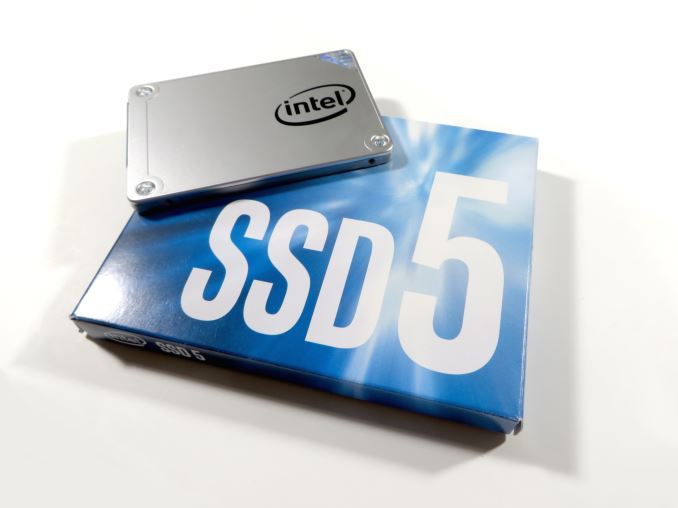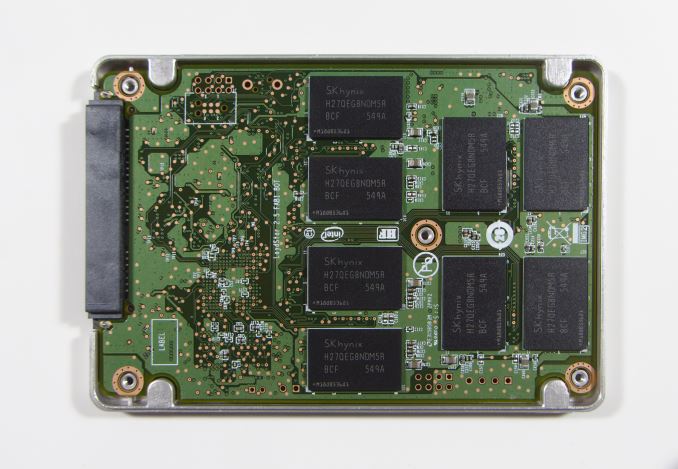The Intel SSD 540s (480GB) Review
by Billy Tallis on June 23, 2016 9:00 AM EST
Every few years, Intel releases a new SSD controller that raises the bar for the whole industry. In between those shake-ups, the competition catches up and surpasses Intel. This pattern is especially pronounced in the consumer SSD market where Intel's mostly enterprise-focused chips cannot keep pace with the constant price cuts. During those interim years Intel turns to third-party controllers to fill the gaps in the product line that their own controllers cannot serve.
This year, Intel's decision to release an affordable mainstream SATA SSD has led them to use a Silicon Motion controller. But "affordable" by today's standards means using 15/16nm TLC NAND flash, and Intel doesn't make that either. They chose not to invest in the 16nm node at IMFT (their flash manufacturing partnership with Micron) so Intel has to buy their flash on the open market.
The result is the Intel 540s, using Silicon Motion's new SM2258 controller and SK Hynix 16nm TLC NAND. The SM2258 controller is the successor to the SM2256, Silicon Motion's first controller designed for use with TLC flash. SM2258 builds on that design by moving from 55nm fabrication to 40nm and incorporating several hardware tweaks including more flexible SLC caching and support for 3D NAND.
The Hynix TLC used in the Intel 540s is the same NAND that is inside the ADATA Premier SP550, one of two products we've tested that use the SM2256 controller. This gives us the opportunity to directly observe what's improved with Silicon Motion's controller and firmware since last year. The price history of the ADATA SP550 also shows that Intel should be able to make the 540s a very affordable product. It also appears that Intel has retired the use of 3xx model numbers to designate entry-level SSDs and all such models are now classified as legacy products.
| Intel SSD 540s Specifications | ||||||
| Capacity | 120GB | 180GB | 240GB | 360GB | 480GB | 1000GB |
| Controller | Silicon Motion SM2258 | |||||
| NAND Flash | SK Hynix 16nm TLC | |||||
| Sequential Read | 560MB/s | |||||
| Sequential Write | 400MB/s | 475MB/s | 480MB/s | |||
| Random Read IOPS | 60k | 71k | 74k | 78k | ||
| Random Write IOPS | 50k | 85k | ||||
| TCG Opal Encryption | No | |||||
| Power Management | Slumber and DevSleep | |||||
| Form Factor | 2.5" 7mm and M.2 2280 | |||||
| Warranty | 5 years | |||||
| Recommended Customer Price | $64 | $79 | $99 | $139 | $174 | $344 |
The 540s has Intel's typical aluminum casing housing a full-size PCB. Our 480GB sample had 16 packages each with two dies of the SK Hynix TLC. The new SM2258 controller uses the same 14mm x 14mm package as the SM2256, with a single external DRAM package next to it. As is typical for low-cost consumer drives, there are no power loss protection capacitors. There is a thermal pad between the controller and the case, something we saw for the SM2256 on the Crucial BX200 but not the ADATA SP550.
The PCB also bears the "Loyd Star" codename which the 540s shares with Intel's SSD E 5400s for the embedded market and the SSD DC S3100 for the enterprise market. The E 5400s covers only small capacities, ranging from 48GB to 180GB while the 540s is available in capacities from 120GB to 1000GB and the DC S3100 covers 180GB to 1000GB. All three product lines include some in-between sizes that are uncommon to find on modern drives. The 540s and E5400s are both available as 2.5" or M.2 drives while the DC S3100 is only available as a 2.5" drive.
For this review, the Intel 540s will primarily be compared against the two SM2256 products we've tested: the ADATA Premier SP550 and the Crucial BX200. The latter shipped with poorly-tuned firmware that made it a disappointment all around, but the former has been a relatively successful budget drive by offering acceptable performance at some of the best prices on the market. The Intel 540s is positioned slightly higher in the market due to carrying a 5-year warranty compared to three years for most budget TLC drives, but in terms of performance that's what it is competing against.
Other important drives to compare against will include the Toshiba OCZ Trion 150, a higher-performing drive using a controller based on the Phison S10 paired with Toshiba 15nm TLC, and the SanDisk X400 using Marvell's 88SS1074 controller and SanDisk's 15nm TLC. The SanDisk X400 seems to be the fastest planar TLC drive on the market, and it is available in both 2.5" and single-sided M.2 form factors. The SanDisk X400 also has a 5-year warranty.
| AnandTech 2015 SSD Test System | |
| CPU | Intel Core i7-4770K running at 3.5GHz (Turbo & EIST enabled, C-states disabled) |
| Motherboard | ASUS Z97 Pro (BIOS 2701) |
| Chipset | Intel Z97 |
| Memory | Corsair Vengeance DDR3-1866 2x8GB (9-10-9-27 2T) |
| Graphics | Intel HD Graphics 4600 |
| Desktop Resolution | 1920 x 1200 |
| OS | Windows 8.1 x64 |
- Thanks to Intel for the Core i7-4770K CPU
- Thanks to ASUS for the Z97 Deluxe motherboard
- Thanks to Corsair for the Vengeance 16GB DDR3-1866 DRAM kit, RM750 power supply, Carbide 200R case, and Hydro H60 CPU cooler












77 Comments
View All Comments
Flunk - Thursday, June 23, 2016 - link
Looks like it's on Intel's low-end product map for well into 2017 (which is as far as that goes).BurntMyBacon - Friday, June 24, 2016 - link
I thought that Intel's low-end was the 300 series. Apparently not anymore:https://benchlife.info/mansion-brighton-stony-beac...
Please post another link to a roadmap if you find one not plastered with a website logo.
JKJK - Thursday, June 23, 2016 - link
520 and 530 stuck with us for forever, even still when they where performance wise surpassed by other manufacturers. And the price didn't budge either, so I suppose 540 will be with us for a while.However, I'm pretty disappointed with Intel on this one. Samsung 750 evo and even 850 evo is way cheaper here in Norway.
Impulses - Thursday, June 23, 2016 - link
They're at price parity in the US right now, 'course the EVO is much better for the money...Flunk - Thursday, June 23, 2016 - link
That's a lot of money to pay for a low-end drive with a Silicon Motion controller. Performance like a Trion, price like an 850 Evo. Good work Intel.BrokenCrayons - Thursday, June 23, 2016 - link
In their defense, it's not a terrible performer relative to other planar TLC drives with the same controller. However, that doesn't excuse the much higher price MSRP. Were I in the market for a new drive, I wouldn't write off TLC, but I would write off the 540 right away based on the cost over its nearest competitors.Guspaz - Thursday, June 23, 2016 - link
So, it's an Intel SSD that doesn't use an Intel controller, doesn't use Intel flash, and provides terrible performance at a much higher prices than the competition.What were they thinking? I've always been a bit of an Intel SSD fanboy (the five standalone SSDs that I've bought over the years have all been Intel, all the way back to the G1), but they've clearly lost their way, and I don't think the next SSD that I buy would be an Intel.
hojnikb - Thursday, June 23, 2016 - link
They probably want to bank on the clueless users, that have little idea of SSD performance but know Intel as a brand.BurntMyBacon - Friday, June 24, 2016 - link
@Guspaz: "So, it's an Intel SSD that doesn't use an Intel controller, doesn't use Intel flash, and provides terrible performance at a much higher prices than the competition."They did use Sandforce controllers for a while. Though their performance was pretty decent at the time. Firmware made the difference in reliability. Since they are still doing their own firmware and validation, I don't think the use of a third party controller or flash is an insurmountable problem. I do think that the product is not priced or named correctly. This should be a 300 series part with a 300 series price.
Note: The relatively high price may be correlated with the fact that they have to acquire flash on the open market and not everything they get is necessarily meeting their validation requirements.
pwil - Wednesday, July 27, 2016 - link
3 in 3xx series means 3y warranty.